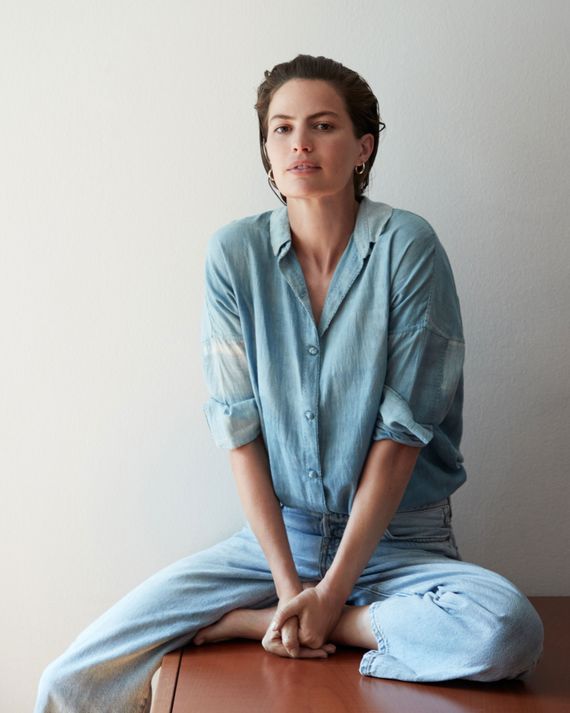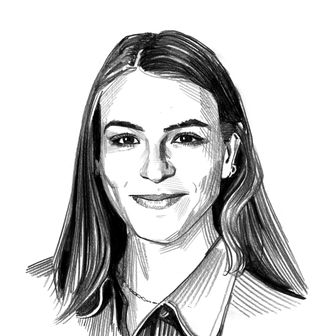
A few years ago, Cameron Russell reached a level of success many young fashion models dream about. She had appeared in campaigns for H&M and Tiffany’s, walked the runway for Prada and Chanel, and fronted covers of Vogue Italia and i-D. Increasingly, brands hired her because she was a respected activist campaigning for the Me Too movement and environmental protection. But when Russell’s agent told her a luxury brand wanted to offer her a million-dollar contract, the job marked a new milestone — a record salary.
As her team finalized the deal, Russell agreed to a test photo shoot. The day started well, she thought. But several hours in, the tenor changed and never recovered. The president of the brand arrived and, without introducing herself, barked orders at Russell. The art director pressured her to pose topless and with fur, both forbidden by her contract. The crew grew tense when she objected. The set, which was a restaurant, started seating diners who ogled as she posed in her underwear. The art director took every opportunity to touch Russell unnecessarily, told her he had recently separated from his wife, and asked to shoot her in lingerie for another brand. Trying to make nice, she agreed, she smiled. Russell felt trapped. The photos looked terrible.
The next day, Russell’s agent called her. The million-dollar deal was off. The CEO saw her test pictures and deemed Russell too “vulgar” for the job.
Russell tells this story in her new memoir, “How to Make Herself Agreeable to Everyone,” in which she details the many subtle and not-so-subtle ways the business of modeling can dehumanize young women, often teenagers who are taught to perform sexual intimacy before they’ve even had their first period. Russell was no longer a teenager but discovered she could still be left feeling compromised and degraded. “How is it that after so many years I’m still letting anyone tell me I must prove how willing I am by showing the crew my tits?” she writes.
When I meet Russell, now 36, on a cloudy morning in midtown, our plan is simply to walk and talk. Russell loves walking, partly because she never learned to drive. When she was 16 and all her friends back home were queuing up at the DMV, Russell was taking the bus to New York City to begin her career as a model. That same year, Women’s Wear Daily picked her as a new model to watch, listing her “secret weapon” as “That face!” Some models succeed because they have strange, otherworldly features, but Russell’s beauty is more classic. She looks like a young Cindy Crawford. At her first industry party, the summer before her junior year of high school, she remembers an agent introducing her to a fashion executive by grabbing Russell’s cheek and saying, “You’re going to make him rich.” He responded, “She’s a gold mine.”
Russell grew up in an ambitious, intellectual family: Her grandfather Robert W. Chase was a diplomat in the Foreign Service, and her mother, Robin Chase, is a successful entrepreneur best known for co-founding Zipcar in 2000. When she started modeling, Russell’s main concern was not to jeopardize a future in politics. “I think they would be embarrassing to have on the cover of Time magazine if I ran for president,” she remembers thinking of her first published photos. Russell’s modeling career took off from the start, earning her thousands of dollars per day of work. “I was happy to miss birthdays and sleepovers and exam dates and days of school and then my grandfather’s funeral because those sums were massive and life-changing,” she tells me as we weave through commuters on Seventh Avenue. After high school, she was shocked to learn she had already made more money modeling than her mother had in her entire career. (Chase had recently been pushed out of Zipcar, three years after it launched, by her board during a period when the company was struggling to raise money.) A decade ago, Russell became known as the “smart model”: She studied political science and economics at Columbia University and in 2012 gave a viral TEDx talk about the privileges of her beauty. It’s one of the top-ten most popular talks in the conference’s history.
Russell interrupts herself to suggest we abandon our walk — it’s starting to rain — and sit at a quiet diner near Columbus Circle to talk more about complicity and power. She writes about being tricked into posing topless by an art director who insisted he was just adjusting her strapless top and dutifully laughing when a former agent sent her porn as a joke. Her mother survived sexual abuse as a child, which informed how her daughter saw men, women, and power. “What I had learned from my mother was become really powerful because your life depends on it,” Russell says between endless refills of coffee.
When I ask if she regrets starting her career so young, Russell doesn’t have a straight answer. Throughout our conversation, she has few straight answers. For someone so willing to expose herself in her writing, she is careful to avoid giving me any sound bites in person. Instead, she quotes Maggie Nelson and Paulo Freire or tells me a story about Vera Rubin’s discovery of dark matter. When I ask about photographers whom models have accused of sexual abuse, she is quiet for 30 long seconds, staring into the distance as she chooses her response. Russell is skeptical of the media’s ability to tell complicated stories. Perhaps after so many years of making herself agreeable to everyone, she is no longer willing to do it, even for the sake of promoting her own book.
Russell started writing about her career shortly before she became a flash point in the Me Too movement. In October 2017, a model friend inspired by the women who had spoken publicly about Harvey Weinstein texted Russell about an experience of sexual abuse at work. Russell offered to post her friend’s text on Instagram, removing her name and all identifying details. Over the next two days, hundreds of people sent Russell stories of rape, assault, manipulation, and pain. She posted nearly a hundred and shared some with other top models, including Kate Upton and Amber Valletta, to post, too. Russell was flooded with interview requests. She connected some models with reporters in the Spotlight Team at the Boston Globe but resolved to tell her story herself. “I started writing because I felt like I just could not find the words,” she says. “Because I’ve been on set since I was 16, I’m so aware of the audience and the performance. I just was like, How do I stop performing? And what do I really feel?”
Like so many models before her, Russell tolerated slimy photographers and touchy art directors because she wanted to succeed. “I had this idea that if I worked my way up to the top, then I would be able to make change,” she tells me. “And when I got there, what I felt was, powerfully, That is not how change works,” she said. Today, she and her partner, the documentary filmmaker Damani Baker, live in Brooklyn with their young children. She still models, though less frequently than she did in her 20s. When she posts about garment workers’ rights or Gaza on Instagram, she knows her career is established enough to withstand potentially alienating brands. “Even clients who I can remember, post-TED, being like ‘that’s too much’ — then years pass, and you’re working together in a different capacity,” she says. “That’s why I have been able to take risks. Because I can still feed my family; I still have a house. There are activists who do that without those backups.”
I ask Russell if she thinks modeling is safer since Me Too began because so many models have gone public with harrowing stories. She says it’s hard for her to evaluate as she is no longer in the early, and most vulnerable, phase of her career. How does she know her activism is working, then? “I don’t,” she says, before turning it back on me. “You’re part of the fashion ecosystem. What do you feel?” She wants her readers to think about the ways they participate in what she calls a “culture of domination” in their own lives.
I think about some of the biggest shifts in fashion in recent years. In 2017 and 2018, models publicly accused several powerful fashion photographers of exploitation and sexual assault. Overnight, some of the industry’s most influential photographers, including Bruce Weber and Patrick Demarchelier, were dropped by all the major magazines and brands. I ask Russell, Wasn’t that some sort of change, however unjust the process was? “I feel like the exit of five people cannot address what’s happening right now,” she says. “And if we think that it can, we are very confused about our complicity.”


